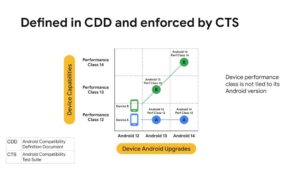Starting from Android 12, manufacturers must specify the performance classes of their devices. This is one of the most relevant innovations (at least for manufacturers) of the new version of the so-called Compatibility Definition Document (CDD), which is the set of rules that must be observed for Google to certify the ability to pre-install its services and applications. These include Play Service, Play Store, Search, Chrome, YouTube and others. The class issue had already been announced at the time of the first Android 12 beta, but the CDD with all the official details was only released a few hours ago.

To clarify, it will not be a subdivision into bands, for example top / high / midrange / entry level, as you might think. It will work like this:
- Each version of Android will introduce a new performance class, identified with the same number (or letter) as the operating system. Android 12 => Performance class 12 (or S); Android 13 => Performance class 13 (or T); and so on. It starts with Android 11: Google has created a “posthumous” one for reference.
- The performance class surprisingly won’t evaluate CPU or GPU power – at least not in the classic way. Screen resolution, camera capabilities and memory speeds will mainly be evaluated, as well as details that we could define as secondary or more advanced – codecs, ISPs, and so on.
- Manufacturers are not forced to adhere to the performance class of the new version of the system: in short, these are not minimum requirements. In the future, it will be possible for a native Android 13 smartphone to fall into performance class 11, for example. It will clearly be a budget device.
- The system could be useful for developers, who may disable different features of their apps based on available hardware.
These are the basic requirements of the two performance classes defined to date in the CDD; the differences between the two are only in the speed of the storage memories:

- Class 12
- At least 6 GB of RAM
- Display: at least 400 DPI and resolution at least 1080p
- Minimum speeds of storage memories:
- 120 MB / s sequential write
- 250 MB / s sequential read
- 10 MB / s random write
- 40 MB / s random read
- Rear camera: at least 12MP, video recording at least 4K / 30 FPS
- Front camera: at least 4MP, video recording at least 1080p / 30 FPS
- Class 11
- At least 6 GB of RAM
- Display: at least 400 DPI and resolution at least 1080p
- Minimum speeds of storage memories:
- 100 MB / s sequential write
- 200 MB / s sequential read
- 10 MB / s random write
- 25 MB / s random read
- Rear camera: at least 12MP, video recording at least 4K / 30 FPS
- Front camera: at least 4MP, video recording at least 1080p / 30 FPS












